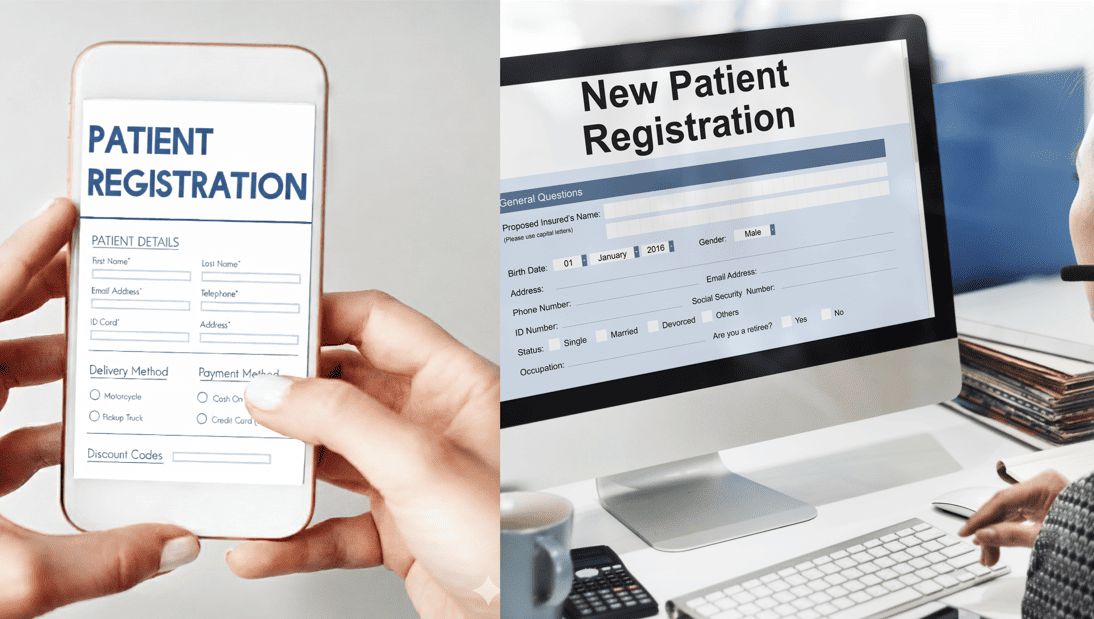Are Google Forms HIPAA Compliant? What Doctors Need to Know
💡 Many clinics wonder if a free tool can safely capture patient data. Short answer: not by default. Compliance requires some controls that Google...
7 min read
Gregory Vic Dela Cruz : Sep 29, 2025 8:00:00 AM

Today, efficiency and compliance go hand in hand in healthcare. Clinics face mounting pressure to reduce administrative burden through automation. At the same time, they're expected to provide an experience that is convenient and secure. Yet many still rely on outdated paper intake forms that slow down workflows. These manual methods increase errors and frustrate patients.
The solution is clear: HIPAA compliant online forms. For providers using eClinicalWorks (eCW), secure digital intake is a gamechanger. Patients can complete registration forms before their visit on their own device. However, clinics must ensure that every data point is handled according to HIPAA. This is why more practices are adopting HIPAA compliant online forms for eCW as a key strategy.
This guide explores what HIPAA compliant online forms are and why they matter. In this article, we'll cover the following:
You’ll also see best practices and learn why Curogram is a trusted platform for digital forms. By the end, you’ll appreciate why these forms keep you compliant and how they drive growth for your practice.
HIPAA compliant online forms are digital intake tools designed specifically for healthcare practices. Their purpose is to securely collect, transmit, and store protected health information (PHI) while maintaining compliance with HIPAA regulations. Unlike generic web forms, they include advanced security features such as encryption in transit and at rest, detailed audit trails for every access or change, and secure authentication for patients and staff. These safeguards ensure that PHI remains private, secure, and fully auditable if a compliance review occurs.
Generic platforms like Google Forms and Typeform are convenient but not designed for medical use. They lack encryption standards, HIPAA business associate agreements (BAAs), and audit logging features that healthcare requires. Using these tools exposes clinics to potential violations and fines, as they cannot guarantee compliance. In contrast, healthcare-grade solutions are built as secure online forms for healthcare. They integrate seamlessly with EMRs, offer customizable templates for different appointment types, and provide HIPAA compliant form builder functionality. This distinction is critical for clinics that must protect PHI while modernizing patient intake.
In short, HIPAA compliant online forms combine the flexibility of digital tools with the rigorous standards of healthcare compliance. They are the foundation for practices that want to streamline intake while safeguarding patient trust.
Intake forms routinely capture PHI—demographics, coverage, medications, and history. HIPAA compliant online forms safeguard that data with encryption, access controls, BAAs, and full audit trails. If questions arise, administrators can prove exactly who accessed what and when, reducing legal exposure and reputational risk.
Paper packets force double work: collect at the front desk, then re-key into the EMR. With EMR integrated intake forms, submissions sync to the correct fields in eClinicalWorks, eliminating transcription, minimizing errors, and freeing staff to support patients instead of typing.
Patients complete online patient registration forms for healthcare at home or on a phone, at their own pace. Clear progress indicators, required fields, and e-signatures keep the experience simple, reduce anxiety at check-in, and improve overall satisfaction.
Handwriting, missing boxes, and misread insurance numbers create costly downstream issues. Secure online forms for healthcare validate fields in real time, require critical answers, and capture clean images of IDs and cards—producing accurate data for clinical and billing teams.
Bad intake data leads to claim edits and denials. When insurance details, subscriber IDs, and coordination of benefits are captured correctly the first time—and mapped directly into the EMR—claims move faster. Clinics see fewer reworks, shorter A/R cycles, and steadier cash flow.
Condition-specific questions and conditional logic surface risk factors before the visit, allowing staff to triage proactively. Automated pre-op instructions, fasting reminders, and location guidance sent with the form reduce day-of confusion and late cancellations.
Mobile-friendly design, plain-language prompts, and multilingual templates help more patients complete forms accurately. Accessibility features (screen-reader compatibility, color contrast, keyboard navigation) ensure patients with disabilities can participate fully—supporting equitable access to care.
Top HIPAA compliant online forms for eCW record immutable logs for each event—view, submit, edit, export—so practices can demonstrate compliance on demand. Centralized template control reduces variation across locations, while role-based permissions and retention policies tighten governance and lower risk during audits or incident reviews.

True efficiency comes from eliminating copy-paste. The best HIPAA compliant forms software connects intake to eClinicalWorks so that demographics, insurance photos, medications, allergies, and consents map to the right fields automatically. With eCW online forms integration, submissions can trigger tasks, update schedules, or flag incomplete data. Integration also ensures that updates appear for clinicians in real time, minimizing back-and-forth during the visit.
Completion rates rise when forms work flawlessly on phones. A mobile-first layout, large tap targets, autosave, and resume-later links reduce drop-off. Multilingual support and built-in accessibility (WCAG-aligned) widen access without custom builds. Patients expect consumer-grade experiences; healthcare can deliver them securely.
Intake should reflect the visit. Specialty packs (e.g., cardiology, dermatology, behavioral health) let clinics ask condition-relevant questions while keeping general intake short. Conditional logic reveals follow-ups only when needed, reducing cognitive load. Templates can be cloned per location or provider to balance standardization and local nuance.
Front desks spend countless hours chasing clean copies of insurance cards and IDs. HIPAA compliant online forms accept secure uploads with device camera capture, auto-crop, and glare detection. Files are encrypted, bound to the patient, and routed into the EMR or document management system with metadata intact.
Submissions should move work forward automatically. Common automations include: creating or updating the patient record, attaching signed consents, notifying the care team of red-flag answers, and placing patients into pre-visit readiness queues. Robust audit logs record every step for compliance.
Verified, one-time access links sent via text or email reduce mis-association while keeping login friction low. Electronic signatures with time stamps and IP/device fingerprints strengthen legal defensibility. Consent packages (financial, privacy, procedure-specific) can be bundled and versioned across specialties and locations.
Field masks (DOB, phone, policy numbers), address validation, and insurance BIN/PCN pattern checks prevent bad data at the source. Required-field logic and inline tips drive completeness. The payoff is fewer claim edits, fewer registration callbacks, and faster reimbursement.
Managers need visibility. Dashboards surface completion rates by provider, location, or appointment type; average time to complete; abandonment points; and % of forms submitted before arrival. Exportable audit logs and granular permissions support audits and internal QA.
Plain-language labels, progress indicators, and “save and finish later” options keep forms approachable. Providing prep instructions inline (e.g., fasting, medication holds, arrival logistics) reduces pre-visit confusion and helps patients arrive ready, which shortens rooming time.
Enterprises need shared templates with local overrides, centralized governance, and consistent branding. A medical practice online forms solution should allow network-wide updates (e.g., a new consent clause) in one place while preserving specialist-specific questions. This combination raises quality without slowing change management.
Consumer form tools can’t sign a BAA, don’t push data into eCW, and lack auditability. They force double entry, create version sprawl, and put PHI at risk. Even “HIPAA-ready” add-ons often break on mobile capture or image uploads, and they rarely provide field-level mapping to EMRs.
Curogram pairs a HIPAA compliant form builder with deep eClinicalWorks integration, giving clinics a complete intake workflow—not just a web form. Patients receive a secure link, complete mobile-friendly forms, upload insurance cards and IDs, and sign consents in minutes. Submissions map into eCW automatically, so front-desk teams don’t re-key data and providers open charts ready to use.
Because Curogram is a healthcare-first platform, it brings guardrails clinics can trust: encryption at rest and in transit, BAAs, role-based permissions, immutable audit logs, and SOC 2 controls. Admin dashboards show completion rates, bottlenecks, and form performance by location or provider. Templates can be standardized network-wide and tailored by specialty to maintain consistency without losing flexibility.
Beyond forms, Curogram integrates intake with messaging, reminders, and payments, creating a single patient journey that reduces calls, speeds check-in, and improves cash flow. Clinics report check-in time reductions of up to 50% and cleaner data that lowers denials. For practices evaluating the top HIPAA compliant online forms for eCW, Curogram’s medical practice online forms solution provides the secure foundation and operational polish needed to modernize intake quickly.
In sum, Curogram is the ideal partner for secure digital forms because of the following reasons:
Run short sessions to practice triaging form queues, verifying ID/insurance uploads, and confirming chart updates. Provide quick-reference guides at the desk.
Pilot with one location or specialty. Validate mappings, notifications, and printing or scanning fallbacks for edge cases. Fix friction before broad rollout.
Track pre-arrival completion, abandonment steps, and time-to-complete. Use micro-surveys to learn where patients struggle and iterate rapidly.
Remove nonessential fields, simplify language, and use conditional logic to shorten paths. Standardize successful patterns across locations.
Paper packets and manual typing don’t belong in a modern clinic. HIPAA compliant online forms deliver mobile-first intake that puts accurate data in the EMR before every visit. When forms integrate with eClinicalWorks, front-desk teams reclaim hours. Providers walk in prepared, and patients experience a calm, fast check-in.
To deploy the best HIPAA compliant forms tool and see real wins quickly, Curogram is the answer. It delivers secure online formsthat patients actually finish and staff actually love. Ready to modernize intake with EMR integrated intake forms?
Explore Curogram and turn paperwork into a seamless, compliant digital flow. Book a quick demo today.

💡 Many clinics wonder if a free tool can safely capture patient data. Short answer: not by default. Compliance requires some controls that Google...

💡 Online patient forms in InSync EMR simplify intake for behavioral health practices. Paper forms are replaced with secure, digital versions...

💡 HIPAA-compliant online forms for Tebra users can transform your practice. They help streamline intake, reduce errors, and improve patient...